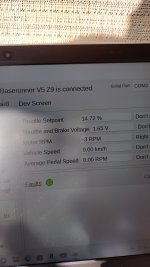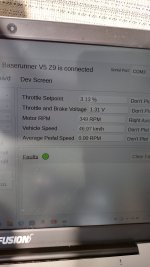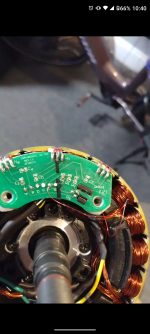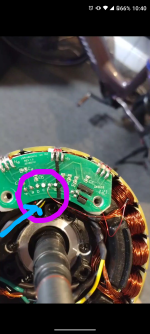I'm at a dead stop sitting on the bike and try to throttle away I get nothing for a few seconds of WOT. If I'm moving even just 2mph the throttle is basically instant. If I take the wheel off the ground also it's instant. However with a load applied at full stop the start time is ridiculously long to get moving and quite frankly dangerous. If anyone were to know of any settings to change that would help that would be great.
When watching the diag screen of the CA (one left button push from main), does the throttle voltage take a long time to rise when acceleration is taking too long, or does it rise instantly like in the other cases?
If it rises instantly, then it's not the CA causing the problem.
If it rises slowly, then the problem is whichever limiting process in the CA has it's flag letter capitalized on the lower left of this screen.
In the former case, it means there is a limiting process going on elsewhere in the system. Some possibilities include:
--the battery is sagging in voltage so much that the power available to the motor under that condition set is too low to do the job (under lesser loads the voltage sag is less so it has enough power to do those jobs)
--the controller is ramping up current based on throttle input, and in this situation the current is needed right now, while in other situations the current is enough even at start of input to do the work required
--the controller is simply limiting current (battery or phase) completely, so that there is never enough to do the startup job, but under lesser load conditions there is.
--the motor simply isn't capable of the torque required for the conditions given, with the available phase current from the controller
You can monitor with the CA to see what the current is during the startup that takes too long, vs that in other situations. If you see the current "brickwall", so it just rises to some point and holds there, then something is limiting this. If the CA's A or W flags are not capitalized, the CA isn't doing it.
You can monitor the voltage with the CA to see if voltage drop (sag) during the startup that takes too long is severe, which essentially limits the wattage because W = V x A; even if A is sufficient a loss of V from a poorly-qualified battery or high-resistance connection between battery and controller will prevent sufficient W from being available.
Every motor has a certain amount of torque it can create given a certain amount of phase current. If the ebikes.ca motor simulator lists your motor then you can directly simulate your conditions and system and see what that torque is, and determine how long it would take to accelerate a given setup in your riding conditions.





